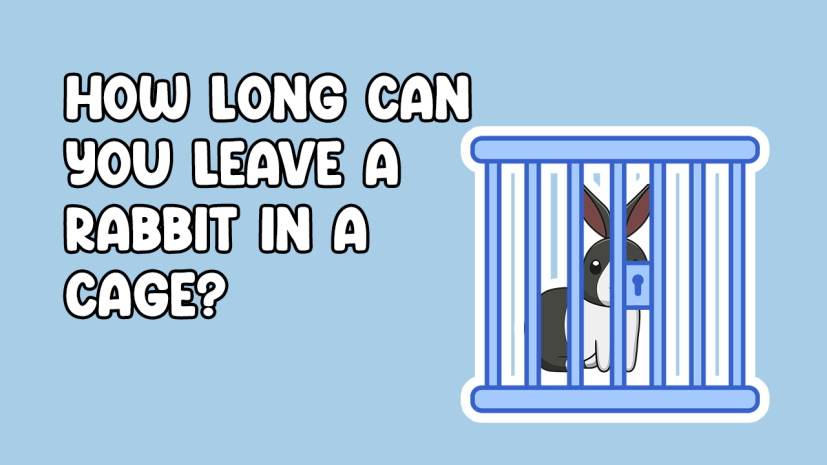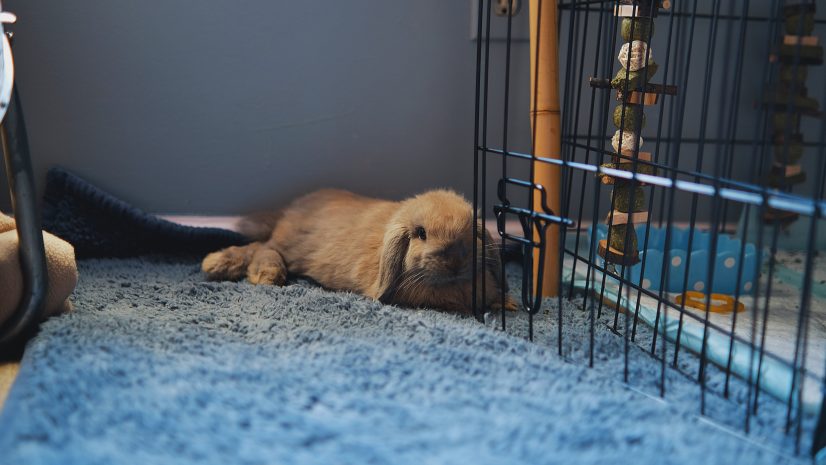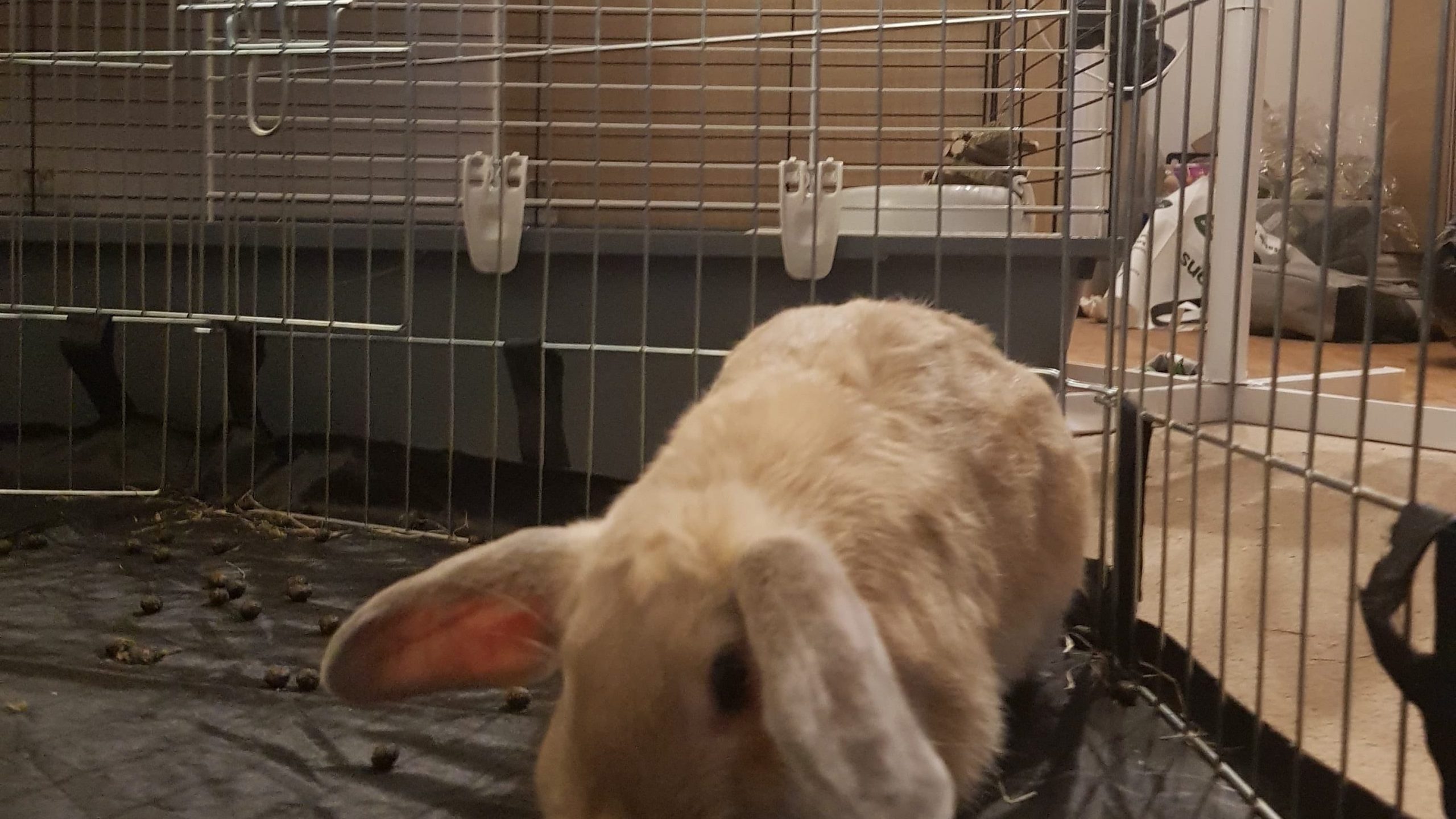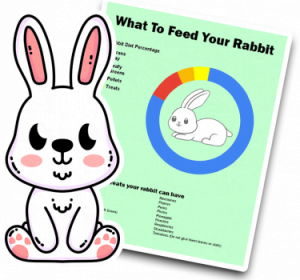
Does your rabbit look bored in its cage? Are you new to the world of rabbits and not sure how long you should be letting your rabbit out of its cage?
An indoor rabbit can spend most of the day in its cage. However, rabbits need room to roam and exercise like any other pet. Rabbits can get bored quite quickly, so you’ll want to give them the right amount of social interaction and exercise to ensure a happy bunny.
Keep reading to learn more about how long your rabbit should be roaming the house and what to do to keep them entertained.

Yes, rabbits get bored in their cages, especially if the cage is small and they have no toys. You may not think so, but rabbits are very active and intelligent animals.
Even when they’re not running around and playing, they must keep their minds and mouths busy. Beyond satisfying their explorative nature, rabbits must also chew to keep their teeth from growing too long.
Most rabbit cages in pet stores are too small for a rabbit to live in full-time. They need room to exercise to stay healthy and prevent boredom.
Many rabbit owners let their rabbits have free run of their homes. Or they a dedicated room where it’s safe and quiet. However, if your rabbit isn’t litter trained, then it may become quite messy for you.
If your rabbit is litter trained, you can give them free rein of your house.
Just make sure there’s always a litter box available. You will also have to pet-proof your home by blocking off certain areas and hiding any wires.

Boredom isn’t good for rabbits. A bored rabbit can develop depression, become overweight, and develop a list of health problems. Being active is a part of a rabbit’s most primal behavior. It’s practically in their DNA.
Further, boredom in rabbits also leads to behavioral issues like chewing and digging up everything they can. This is because it’s in a rabbit’s nature to be curious and explore its surroundings.
If your rabbit is bored in its cage, it will let you know. Here are some ways to tell your rabbit is bored and needs some exercise time.
Your rabbit can become bored outside of its cage as well. If it’s possible, it’s best to give your bunny free access to your house. This ensures that your bunny never gets bored or is short of exercise.
You wouldn’t think so, but these little guys are very active. Rabbits need exercise to keep themselves healthy, specifically for good digestion and weight management.
Lack of exercise can cause intestinal issues, as well as obesity. If your rabbit becomes overweight, this can cause arthritis or heart problems.
Rabbits need at least 4 hours to run and play outside of their cage, whether it’s free to roam or has an exercise pen. This time should be split into 2-hour intervals in the morning and evening to best fit a rabbit’s instinctual habits.
Rabbits are crepuscular by nature. This means that they are most active at dawn and dusk. Take note of when your rabbit is most active and adjust its playtime accordingly.
If your rabbit is bored in its cage, it will let you know. Here are some ways to tell your rabbit is bored and needs some exercise time.
Your rabbit can become bored outside of its cage as well. If it’s possible, it’s best to give your bunny free access to your house. This ensures that your bunny never gets bored or is short of exercise.

You wouldn’t think so, but these little guys are very active. Rabbits need exercise to keep themselves healthy, specifically for good digestion and weight management.
Lack of exercise can cause intestinal issues, as well as obesity. If your rabbit becomes overweight, this can cause arthritis or heart problems.
Rabbits need at least 4 hours to run and play outside of their cage, whether it’s free to roam or has an exercise pen. This time should be split into 2-hour intervals in the morning and evening to best fit a rabbit’s instinctual habits.
Rabbits are crepuscular by nature. This means that they are most active at dawn and dusk. Take note of when your rabbit is most active and adjust its playtime accordingly.
Depending on your rabbit’s size, you will need to find an appropriately sized cage to give them enough space. This is also true for exercise pens or outdoor runs.
For an average-sized rabbit, a cage of 30”x30”x24” is the minimum space your rabbit needs in a cage. Exercise pens and runs should be around 12 square feet or larger.

Rabbits crave social interaction, whether it’s with you, your other pets, or another rabbit. In the wild, rabbits live in colonies of up to 20. It’s well-known that rabbits are better in pairs if you aren’t able to give them enough attention.
If you can’t have a pair of rabbits, just note that you should be spending a lot of time with them, especially in the beginning to establish a bond. But, when it comes to quality cuddling time or playtime, a couple hours is usually enough to keep your bunny happy.
If rabbits don’t get enough attention, they can become lonely and depressed. If this is the case, you will notice your rabbit acting abnormally, like:
Rabbits are very playful animals. They may not fetch like dogs or chase after feather-toys like cats, but they do enjoy playtime. Plus, it helps keep their minds active and their bodies healthy.
Rabbits will play different ways, depending on whether they’re playing with you, on their own, or with another rabbit. Let’s look more into the different ways a rabbit plays.
Bonded rabbits will often play by playing their version of leapfrog. One rabbit rushes towards the other, and the other rabbit leaps to avoid it. They will also chase each other around. And when it’s all over, they’ll cuddle and nap together.
By themselves, rabbits exhibit playful behavior by tossing and pushing things around. You can buy toys for your rabbits or make your own to keep your rabbit entertained.

It’s not well-known, but rabbits do indeed have a playful side. While it’s more likely to come out while interacting with other rabbits, you can get to know how your rabbit likes to play best. For example, a rabbit will signal their desire to play by running in circles around you.
There are many different ways to play with your rabbit. You can give them toys to play with, use treats to engage their foraging instincts, and even create a mini playground for them.
Reverse Fetch is a game you can play with your rabbits. As the name suggests, it’s the total opposite of the type of fetch you would play with a dog. In reverse fetch, you simply give your rabbit his favorite toy, watch him toss it, and push it around.
Another game you can play with your rabbit is “Catch Me If You Can.” Your rabbit will bump you, run away until you “bump” them back. Your rabbit may even chase you back.
Some rabbits love to play “Tug Of War,” where they will pull pieces of paper, treats, or cardboard from you. It’s not as challenging as a bigger animal, but it’s fun either way.
Willow balls make great toss toys. Even better, your rabbit can chew them for their dental health and save the furniture around your house!
Treat-Dispensing Toys are a great way to occupy your rabbit’s mind by using treats to gain interest and puzzles for enrichment. This also helps them to interact with their natural foraging habits.
You can make a DIY hay-dispensing toss toy by cutting notches into a toilet paper roll and stuffing it with hay. It’s inexpensive and will keep your rabbit occupied until the hay’s all gone.
Rabbits love to burrow. You can help them stay entertained by creating a maze out of blankets and pillows for them to navigate through.
Your rabbit will burrow in and out until they find a spot to get cozy.
Hanging treats with string and clothespins keeps your rabbit entertained and motivates them to stretch. You can even do this right indie your rabbit’s cage.
Tunnels and Bridges around your rabbit’s exercise pen will give them some enrichment. Contrary to belief, rabbits do like to climb, though not very high. Having a bridge to climb up on or some steps can be a great way to encourage your rabbit to explore.
Since rabbits get bored so easily, it’s crucial to make sure they get enough time to get enough exercise and mental stimulation. Nothing should be stuck in a small cage all day and night. Think about it. Wouldn’t you get bored?
If you litter-train your rabbit and pet-proof your home, you can leave your rabbit out all the time. This is typically best if it’s safe for your rabbit to be unsupervised. Of course, this isn’t always the case.
There are plenty of ways to make things fun for your rabbit, whether it’s playing, giving them toys, or by sprucing up the room that it’s equipped to make a happy rabbit.

By entering your email address you agree to receive emails from Cottontailclub. We'll respect your privacy and you can unsubscribe at any time.